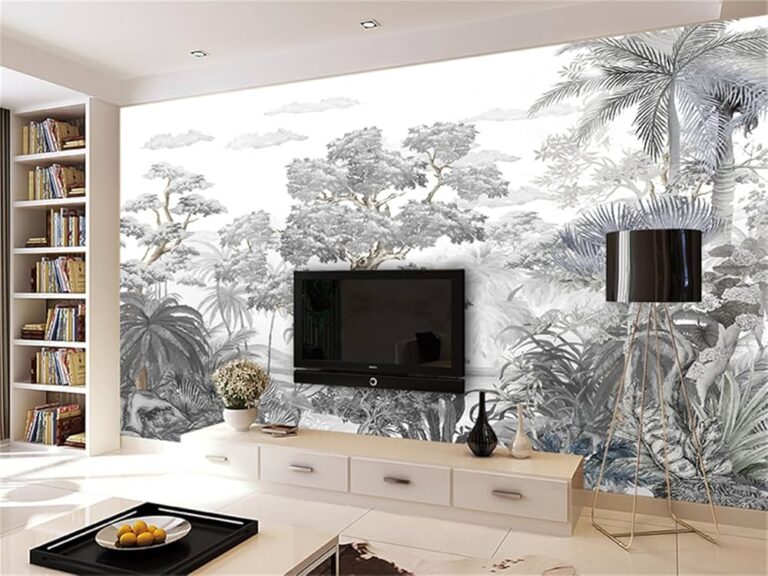
Expert Tips for a Successful Wallpaper Installation and Removal Project
Wallpaper can be a fantastic way to transform any space, whether you’re adding a bold accent wall, enhancing the aesthetic of a room, or creating a cozy ambiance. However, installing and removing wallpaper can be a challenging and time-consuming task if not done correctly. To help ensure your wallpaper installation or removal project goes smoothly, we’ve gathered expert tips that will guide you through each step.
1. Preparation is Key
Whether you’re installing or removing wallpaper, proper preparation is crucial. For installation, ensure your walls are clean, smooth, and free of any imperfections like cracks, holes, or peeling paint. Patching and sanding the walls before applying the wallpaper will ensure a smooth surface, allowing the adhesive to bond properly. For wallpaper removal, start by assessing the type of wallpaper you’re dealing with. Some wallpapers are peel-and-stick, while others require water or a chemical solution for easier removal. Remove all furniture from the area, cover the floors with drop cloths, and wear protective gear such as gloves and safety glasses to prevent any injuries or irritation from chemicals.
2. Measure and Cut Accurately
One of the most important steps in wallpaper installation is measuring and cutting the wallpaper accurately. Measure the height and width of each wall and ensure that the wallpaper you’ve purchased is enough to cover the surface. Always add extra inches at the top and bottom to ensure proper alignment. Use a sharp utility knife or scissors to cut the wallpaper to size. For precise cutting, measure each piece carefully and be mindful of patterns or seams. For patterned wallpaper, it’s essential to align the pattern correctly, which can be tricky. Take your time with this step, as proper measurements and alignment will ensure a flawless finish.
3. Choose the Right Adhesive
Selecting the right adhesive for your wallpaper is crucial for a long-lasting and professional finish. Different types of wallpaper require different adhesives, so always follow the manufacturer’s recommendations. Paste-the-wall wallpaper is becoming increasingly popular, as it’s easier to apply and remove. For traditional wallpaper that needs paste, you can either use pre-mixed wallpaper paste or mix your own. Ensure the paste is spread evenly on the wallpaper to avoid air bubbles or uneven adhesion. Be cautious not to use too much paste, as this can cause wallpaper to become soggy and difficult to handle.
4. Take Your Time and Work in Sections
Wallpaper installation can be a meticulous process, so take your time and don’t rush. Begin by working from top to bottom and apply the first strip of wallpaper vertically. Align the wallpaper carefully with the edge of the wall and press it firmly into place. Use a wallpaper brush or smoother to eliminate air bubbles and smooth out the edges. For the best results, work in sections to ensure each piece aligns perfectly with the next. This approach prevents mistakes and helps keep the pattern consistent. Don’t hesitate to use a level or plumb line to ensure that the wallpaper is perfectly straight. Small adjustments during the installation process can save time and effort later.
5. Keep the Edges Clean
As you install the wallpaper, be mindful of the edges. Any excess wallpaper should be trimmed carefully using a utility knife for a neat, seamless look. To achieve clean edges, press the wallpaper into corners, around windows, and along baseboards, making sure it adheres well. For wallpaper removal, this step is equally important. Once the wallpaper is removed, there may be some residual adhesive left behind on the wall. Use a sponge or cloth with warm water and mild detergent to clean the surface before reapplying new wallpaper or paint. Removing any leftover glue is essential to ensure the new wallpaper will adhere properly.
6. Wallpaper Removal Made Easy
Removing wallpaper can be a laborious task, especially if the wallpaper has been in place for many years. However, with the right tools and techniques, you can make the process much easier. Start by testing a small area of the wallpaper to determine if it comes off easily. If it’s stubborn, use a wallpaper removal solution, or simply water to soften the adhesive. For stubborn patches, use a wallpaper scraper to gently peel the paper away, taking care not to damage the drywall underneath. For stubborn glue, you may need to use a sponge soaked in a water-vinegar mixture or a commercial wallpaper removal solution to loosen the remaining adhesive. Be patient during this process; removing wallpaper carefully will prevent unnecessary damage to your walls.
Consider Hiring a Professional
Avoid DIY Stress with Professional Help
Hiring experts ensures a hassle-free wallpaper installation or removal, eliminating the stress and mistakes often associated with DIY attempts.
Expertise for Flawless Results
Professionals bring experience, tools, and precision to the job, delivering smooth and efficient outcomes that enhance your space’s appearance.
Guidance for the Perfect Wallpaper Choice
Experts assist in selecting the ideal wallpaper and adhesive, ensuring compatibility and a lasting, beautiful finish for your home or business.
Wallpaper installation and removal projects can be challenging, but with careful planning and the right techniques, you can achieve beautiful and long-lasting results.
From preparing the walls properly to using the right adhesive and tools, taking your time with each step will help ensure that your wallpaper is applied smoothly and seamlessly. If you’re unsure about any part of the process, don’t hesitate to seek expert advice or hire a professional to assist you. Whether you’re looking to refresh your space with new wallpaper or remove old designs, following these expert tips will lead to a successful project that enhances the aesthetic of your home or business.
Transforming spaces with quality craftsmanship and trusted service. Contact us today!
Services
- Residential & Commercial Painting
- Flooring
- Wallpaper
- Drywall Repairs
- Carpentry Finish
- Power Washing
Information
Philadelphia, PA
info@niccosproservices.com
978-984-3764

